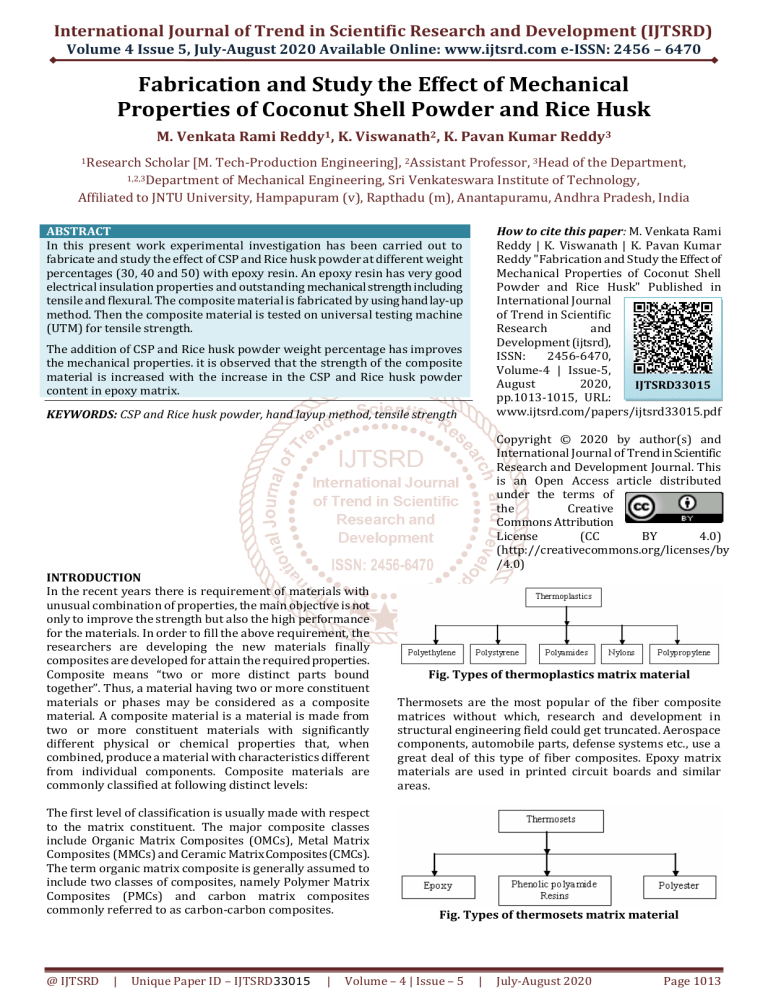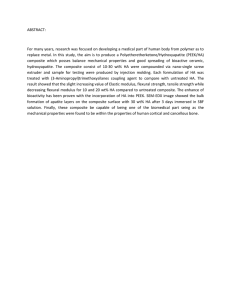
International Journal of Trend in Scientific Research and Development (IJTSRD)
Volume 4 Issue 5, July-August 2020 Available Online: www.ijtsrd.com e-ISSN: 2456 – 6470
Fabrication and Study the Effect of Mechanical
Properties of Coconut Shell Powder and Rice Husk
M. Venkata Rami Reddy1, K. Viswanath2, K. Pavan Kumar Reddy3
1Research
Scholar [M. Tech-Production Engineering], 2Assistant Professor, 3Head of the Department,
1,2,3Department of Mechanical Engineering, Sri Venkateswara Institute of Technology,
Affiliated to JNTU University, Hampapuram (v), Rapthadu (m), Anantapuramu, Andhra Pradesh, India
ABSTRACT
In this present work experimental investigation has been carried out to
fabricate and study the effect of CSP and Rice husk powder at different weight
percentages (30, 40 and 50) with epoxy resin. An epoxy resin has very good
electrical insulation properties and outstanding mechanical strength including
tensile and flexural. The composite material is fabricated by using hand lay-up
method. Then the composite material is tested on universal testing machine
(UTM) for tensile strength.
How to cite this paper: M. Venkata Rami
Reddy | K. Viswanath | K. Pavan Kumar
Reddy "Fabrication and Study the Effect of
Mechanical Properties of Coconut Shell
Powder and Rice Husk" Published in
International Journal
of Trend in Scientific
Research
and
Development (ijtsrd),
ISSN:
2456-6470,
Volume-4 | Issue-5,
August
2020,
IJTSRD33015
pp.1013-1015, URL:
www.ijtsrd.com/papers/ijtsrd33015.pdf
The addition of CSP and Rice husk powder weight percentage has improves
the mechanical properties. it is observed that the strength of the composite
material is increased with the increase in the CSP and Rice husk powder
content in epoxy matrix.
KEYWORDS: CSP and Rice husk powder, hand layup method, tensile strength
Copyright © 2020 by author(s) and
International Journal of Trend in Scientific
Research and Development Journal. This
is an Open Access article distributed
under the terms of
the
Creative
Commons Attribution
License
(CC
BY
4.0)
(http://creativecommons.org/licenses/by
/4.0)
INTRODUCTION
In the recent years there is requirement of materials with
unusual combination of properties, the main objective is not
only to improve the strength but also the high performance
for the materials. In order to fill the above requirement, the
researchers are developing the new materials finally
composites are developed for attain the required properties.
Composite means “two or more distinct parts bound
together”. Thus, a material having two or more constituent
materials or phases may be considered as a composite
material. A composite material is a material is made from
two or more constituent materials with significantly
different physical or chemical properties that, when
combined, produce a material with characteristics different
from individual components. Composite materials are
commonly classified at following distinct levels:
Thermosets are the most popular of the fiber composite
matrices without which, research and development in
structural engineering field could get truncated. Aerospace
components, automobile parts, defense systems etc., use a
great deal of this type of fiber composites. Epoxy matrix
materials are used in printed circuit boards and similar
areas.
The first level of classification is usually made with respect
to the matrix constituent. The major composite classes
include Organic Matrix Composites (OMCs), Metal Matrix
Composites (MMCs) and Ceramic Matrix Composites (CMCs).
The term organic matrix composite is generally assumed to
include two classes of composites, namely Polymer Matrix
Composites (PMCs) and carbon matrix composites
commonly referred to as carbon-carbon composites.
Fig. Types of thermosets matrix material
@ IJTSRD
|
Unique Paper ID – IJTSRD33015
|
Fig. Types of thermoplastics matrix material
Volume – 4 | Issue – 5
|
July-August 2020
Page 1013
International Journal of Trend in Scientific Research and Development (IJTSRD) @ www.ijtsrd.com eISSN: 2456-6470
Epoxy resins are widely used in filament-wound composites
and are suitable for moulding prepress. They are reasonably
stable to chemical attacks and are excellent adherents having
slow shrinkage during curing and no emission of volatile
gases. These advantages, however, make the use of epoxies
rather expensive. Also, they cannot be expected beyond a
temperature of 140ºC.
Materials:
The following are the main raw materials used in this work
Coconut shell powder and Rice husk powder
Epoxy resin
Hardener
The coconut shell powder and rice husk powder are used as
reinforcement. Thermoset polymer epoxy (araldite LY-556)
and Hardener is triethylene tetramine (HY-951) are used for
making composite material.
Preparing of coconut shell powder and rice husk
powder:
Materials used in this experimental work are Epoxy resin,
Hardener and Coconut shell powder. Epoxy resin is a
thermosetting epoxy resin of medium viscosity, India having
outstanding properties as the matrix material like excellent
adhesion to different materials, high resistance to chemical
and atmospheric attack, high dimensional stability, excellent
mechanical properties, nontoxic nature and negligible
shrinkage. Hardener is used to harden matrix material. The
chemical composition of coconut shell powder consists of
Lignin (29.4%), Pentosans (27.7%), Cellulose (26.6%),
Moisture (8%), Solvent Extractives (4.2%), Uronic
Anhydrides (3.5%) and Ash (0.6%).
The cleaned coconut shells were crushed into small pieces by
using hammer. These small pieces then converted into
powder by using hammer. The collected powder was then
sieved to different mesh sizes. For discriminating different
CSP particle size about 1000g of CSP was put over the sieve
shaker and shaken it for 20 min.
Step 5
: Mixture is mixed thoroughly for 2-5 minutes to
form homogeneous.
Step 6 : Mould releasing spray is sprayed all over the
mould for easy erection of laminate from moulds.
Step 7 : Coconut shell powder is mixed with epoxy resin
and hardner then poured according to the required
percentages.
Step 8 : Remaining portion of specimen is poured the
mixture, place the OHP sheep over it and roll
thoroughly to ensure that no void spaces.
Step 9 : Leave the mould for 24 hours for curing to get
solidified composite laminate.
Step 10 : After that remove the composite material
carefully without any damage.
Fig. fabricated composites placed for 24 hours to
solidify
Characterization of mechanical properties:
Tensile test:
Tensile test generally performs on flat specimen. Test of
composite sample is carried out in ASTM D3039 standard. In
this, a uniaxial load was applied through both the end.
Samples are tested at a cross head speed of 10 mm/min, in a
universal testing machine (UTM). Tensile test specimen sizes
as per ASTM D3039
Testing and Results:
Tensile testing:
Three samples are taken for each test and average value of
them is taken into consideration.
Tensile strength is defined as the ability of a material to
support axial load without rupture and is determined
through the tensile test. When equal and opposite forces are
applied simultaneously at both the ends that pulls the
material, it tries to elongate it and the diameter reduces. The
test specimen and general setup has been shown given
below.
Fig. Coconut shell powder
Fig. Rice husk powder
Fabrication of composite:
Fabrication steps
Step 1 : Preparation of mould by using acrylic sheet in
required dimensions.
Step 2 : preparation of CS and RH powder in required
dimensions.
Step 3 : Weighing of epoxy resin into bowl of 50g.
Step 4 : Weighing of hardner into the same bowl of 5g i.e.,
(10:1) mixing ratio of hardner and epoxy.
@ IJTSRD
|
Unique Paper ID – IJTSRD33015
|
S.
NO.
1
20% CSP Filled composite
Tensile
Strength (Mpa)
19.23
2
30% CSP Filled composite
17.05
3
40% CSP Filled composite
14.64
Table Tensile test result
SAMPLE
Flexural testing:
Three samples are taken for each test and average value of
them is taken into consideration.
Volume – 4 | Issue – 5
|
July-August 2020
Page 1014
International Journal of Trend in Scientific Research and Development (IJTSRD) @ www.ijtsrd.com eISSN: 2456-6470
S.
NO.
1
2
3
Flexural
strength (MPa)
20% CSP Filled composite
83.38
30% CSP Filled composite
86.45
40% CSP Filled composite
73.92
Table Flexural test results
SAMPLE
Discussions:
The comparison of between the CSP and Rice husk powder
percentage and tensile strength is considered of three
samples at different percentages 30, 40 and 50.
filler volume the tensile strength goes on decreasing.
Thus, the rate of decrease of tensile strength from 20%
to 30% and 30% to 40% CSP filled epoxy composite is
approximately constant. The maximum flexural strength
is obtained for the composite prepared with 30% CSP
filled while; the flexural strength is minimum for the
composite prepared with 40% CSP filled.
The flexural strength curve shows that an increase of
filler volume flexural strength increases from 20% to
30%, while, the flexural strength decreases on
increasing filler volume from 30% to 40%. Thus, the
rate of decrease of flexural strength from 30% to 40% is
greater than the rate of increase from 20% to 30% CSP
filled composite.
References:
[1] T. Prakash, “Processing and Characterization of Natural
Fiber Reinforced Polymer Composites,” Bachelor’s
Thesis, National Institute of Technology, Rourkela,
2009.
[2] S. Husseniyah, M. Mostapha,” The effect of filler content
on properties of coconut shell filled polyester
composites”, Malaysian polymer journal, vol.6, No-1, p
87-97.(2011)
Fig. tensile strength v/s CSP percentages
[3] Pradhan, K. S., Dwarkadasa, S. E., Reucroft, J. P.,”
Processing and characterization of coconut shell
powder filled UHMWPE” Materials science and
Engineering A Journal”, 367(1-2), pp.57-62. (2004)
[4] Bledzki, A. K. and Gassan, J. “Composite reinforced with
cellulose fiber” Prog. Polymer science Journal, 24 (1),
pp.221-274. (1999)
Fig. Flexural strength v/s CSP percentages
Conclusions:
The experimental investigation on mechanical properties viz.
density, tensile strength and flexural strength of CSP epoxy
composite material is greatly influenced by the CSP filled
volume fraction.
The maximum tensile strength is obtained for the
composite prepared with 20% CSP volume fraction. The
tensile strength curve (See Fig. 6) shows an increase of
@ IJTSRD
|
Unique Paper ID – IJTSRD33015
|
[5] Sapuan, S. M., Harimi, M., &Maleque, M. A., “Mechanical
properties of Epoxy/coconut shell filler particle
composites”. The Arabian Journal for science and
Enginering28 (2B), pp.171-181. (2003)
[6] Joseph, P. V., Kuruvilla J, Thomas S., “Composites
science and technology”: 59(11): pp.1625-1640.
(1999).
[7] Jain, S., Kumar, R., Jindal, U. C.”Mechanical behavior of
bamboo and bamboo composites,” J. Material Science,
27, pp.4598-4604.
Volume – 4 | Issue – 5
|
July-August 2020
Page 1015


